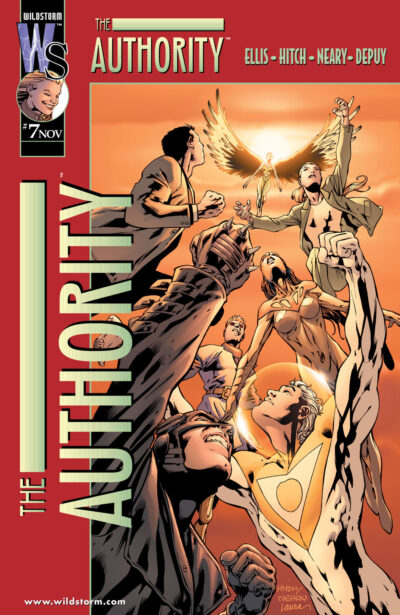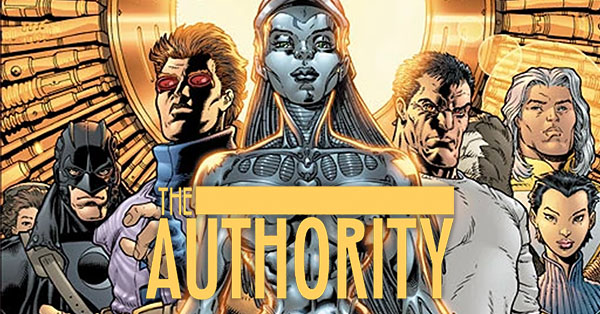What?! A second new guide today for Patrons of CK? Indeed, it’s true – plus an essay on comics history for everyone. I’m once again breaking ranks from following the release schedule of the original launch books of Image Comics, because today’s Guide to Stormwatch requires a second guide to complete it. That’s right, it’s a guide to what came after the Storm, a comic which fundamentally altered the tone and style of the comics industry and which has been tapped as an potential feature film in the new DC Cinematic Universe. It’s my Guide to The Authority!
If you don’t know your early 2000s comic history, buckle up for a brief crash course on how the comics on your current pull list are undeniably influenced by The Authority.
It all starts with a pair of British creators, Warren Ellis and Bryan Hitch. Both had made moderate names for themselves at Marvel – Ellis on Excalibur and Doom 2099, Hitch on Sensational She-Hulk and Marvel UK titles. Yet, neither had become a breakout star who could sell a book on their name alone.
Ellis took over the flagging WildStorm co-flagship Stormwatch in July 1996. It had just recently acquired an all-new cast and had a virtually non-existent fan-base. While Ellis had enjoyed some freedom working on the fringe of Marvel’s titles, here he truly could write whatever he wanted.
What he wanted to write was influenced by Bryan Hitch joining him on on Stormwatch (1997) #4, where they introduced a pair of new heroes – Midnighter and A

pollo. Hitch’s art wasn’t too far from the typical image mold and his figures had the liquidity of his UK predecessor Alan Davis. Yet, Hitch was unique not only in his unflagging attention to detail, but also in his panelling. As he continued on the 1997 series, he strayed farther and farther from typical comics paneling and into what became known as a “widescreen” approach to comics – using pages comprised mostly of stacked full-width panels, punctuated by single-page splashes and double-page spreads.
Hitch wasn’t the first artist to use fewer and wider panels. However, he was the artist who combined the style with intense, realistic detail and modern computer coloring. It made his panels feel like individual frames of film, which in turn had an effect on Ellis’s scripting – which packed in less dialog and let the pictures tell the story. Issues became decompressed, packing in fewer panels and less dialog.
Stormwatch was suddenly a hot comic, for the first time since its initial launch in 1993. But, Ellis didn’t simply want to write about a team keeping watch on Earth from a space station. Much like how X-Force emerged from the New Mutants nearly a decade before to usher in the Image era of extreme comics filled with guns and pushes, Ellis wanted to take Stormwatch on the offensive. But, he had bigger guns in mind than… just guns.
Ellis and Hitch launched The Authority in May 1999, now for a WildStorm that was a wholly-owned imprint of DC Comics.
In just a few months, Hitch’s art had become even more cinematic and more detailed. The Authority #1 was like reading a movie. If Morrison had just shaken up the idea of a Big Two super team on their 1997 relaunch of JLA, this was Ellis’s response – a bigger book with bigger heroes making more brutal choices than the JLA ever could, facing off against foes whose intended casualties weren’t single bystanders but entire cities or whole slices of the universe
Ellis and Hitch lasted only 12 issues on The Authority before handing it off to Mark Millar for an even more brutal and profane run. However, the book was already a smash hit when Marvel launched its line of Ultimate Comics in September 2000 in attempt to refresh their valuable superhero IP. Though the line began with a back-to-basics modern day take on Spider-Man, Marvel had intentions of expanding it to include all of their marquee heroes.
That included the Avengers, who were launched as The Ultimates in 2002 by a pair of familiar faces in this story: Mark Millar and Bryan Hitch. While The Ultimates didn’t have the universal scope of The Authority, it did have Hitch’s visual language and Millar’s brutality. The trademark style of Authority, already a hit for WildStorm, had gone mainstream. And, that wasn’t just in The Ultimates. Hitch’s widescreen style started appearing throughout the Big Two; the indie trend he created at Image and WildStorm had caught on.
We could continue drawing a line from The Authority to The Ultimates to the comics on your pull list today. Look at Avengers Disassembled and New Avengers by Brian Bendis and David Finch. They feel like The Ultimates imported into the main Marvel-616 in both look and tone. That was the book that made The Avengers into Marvel’s hottest team book. Look at the rise of hyper-realistic artists like Adi Granov and Greg Land as sequential interior pencilers, which only work because of the visual language established by Hitch. And, in 2013 was The Ultimates that Marvel used to influence the characters and visual language of The Avengers debut in the MCU.
None of that would’ve happened without the trickle-down effect of Warren Ellis taking over WildStorm’s little-read co-flagship back in 1996, where he was joined by Bryan Hitch two years later.
Want instant access to this Guide to The Authority, as well to my guides to Stormwatch and all of the Image Comics launch titles from 1992 my Crushing Comics Guide to Indie & Licensed Comics? Become a Patron of CK for as little as $1 a month or $10.20 a year to gain access to this exclusive guide and over 70 other guides months before the general public gains access!
Exclusives for Crushing Cadets ($1/month): 46 Guides!
DC Guides (6): Batman – Index of Ongoing Titles, Batman: Legends of the Dark Knight, Green Lantern Corps, Green Lantern: Hal Jordan, Green Lantern: Kyle Rayner, Omega Men
Marvel Guides (27): Adam Warlock, Alpha Flight, Angela, Beta Ray Bill, Black Cat, Blade, Captain Britain, Dazzler, Domino, Dracula, Drax the Destroyer, Elsa Bloodstone, Emma Frost – White Queen, Gamora, Heroes For Hire, Legion, Marvel Era: Marvel Legacy, Mister Sinister, Sabretooth, Spider-Ham, Star-Lord, Thunderstrike, Valkyrie, Vision, Weapon X, Werewolf by Night, X-Man – Nate Grey
Indie & Licensed Comics (13): The Authority, Brigade, Lumberjanes, Codename Strykeforce, Cyberforce, Pitt, Princeless & Raven The Pirate Princess, Savage Dragon, ShadowHawk, Stormwatch, Supreme, WildCATs, WildStorm Events
Exclusives For Pledgeonauts ($1.99+/month): 77 Guides!
All of the 46 guides above, plus 31 more…
DC Guides (16): Animal Man, Aquaman, Books of Magic, Catwoman, Doctor Fate, Flash, Harley Quinn, Houses & Horrors, Infinity Inc., Justice League, Justice Society of America, Mister Miracle, Nightwing, Outsiders, Suicide Squad, Swamp Thing
Marvel Guides (13): Darkhawk, Falcon, Gwenpool, Hellcat – Patsy Walker, Kang the Conqueror, Loki, Power Pack, Red She-Hulk, Sentry, Silk, Spider-Gwen, Spider-Man: Miles Morales, Venom
Indie & Licensed Comics (2): Teenage Mutant Ninja Turtles – IDW Continuity, Teenage Mutant Ninja Turtles – Mirage Studios Continuity
